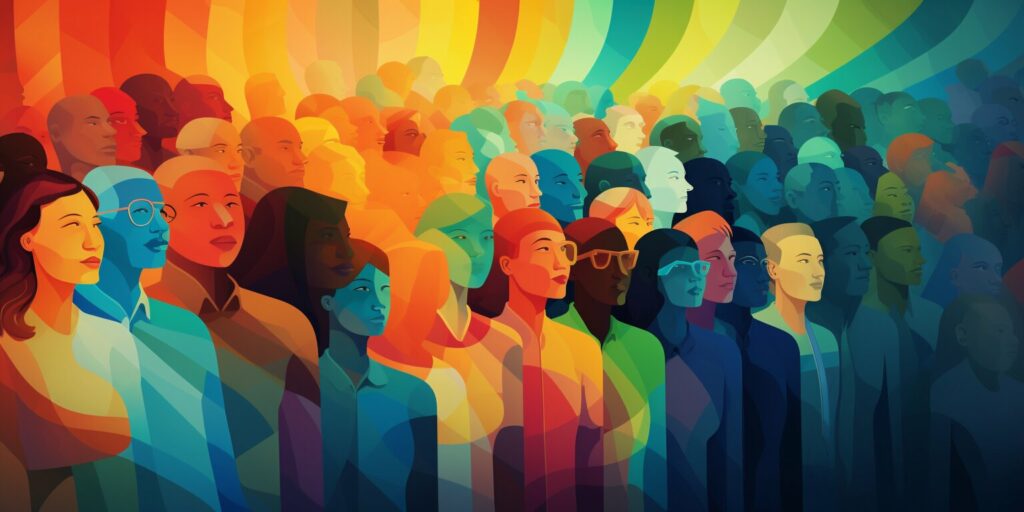Welcome to our guide on promoting inclusivity and reducing prejudice. In a society that struggles with racial bias, discrimination, stereotypes, and biased beliefs, it is crucial to take practical steps toward fostering a more inclusive and accepting environment. By acknowledging the existence of prejudice and understanding its impact, we can work towards challenging prejudiced attitudes and creating a society built on empathy and tolerance.
Understanding Prejudice: Unveiling Bias and Stereotypes
Prejudice is a complex and pervasive issue in our society that encompasses various forms of bias and discriminatory beliefs. This section aims to explore the different facets of prejudice, shedding light on how stereotypes and biases contribute to its perpetuation.
Stereotypes, often based on limited or distorted information, are deeply ingrained societal beliefs about certain groups or individuals. They can shape our perceptions, judgments, and behaviors, leading to biased attitudes and discriminatory actions. Stereotypes fuel prejudice by reinforcing preconceived notions and perpetuating social biases.
Implicit bias, also known as unconscious bias, refers to the unconscious preferences or prejudices we hold towards certain groups or individuals. These biases can influence our decisions and actions, even though we may not consciously be aware of them. Understanding implicit bias is crucial in addressing prejudice, as it helps us identify and challenge our own ingrained biases.
Social bias encompasses the systemic biases and structural inequalities that exist in society. These biases are deeply rooted and affect various domains, including education, employment, and criminal justice. Recognizing and addressing social bias is essential in dismantling institutional barriers and promoting a more inclusive society.
To combat prejudice, it is crucial to recognize and challenge biased beliefs. By critically examining our assumptions and stereotypes, we can cultivate empathy, promote tolerance, and embrace diversity. It requires an ongoing effort to unlearn ingrained biases and actively engage in conversations that challenge prejudiced attitudes.
Key Takeaways:
- Stereotypes contribute to prejudice by reinforcing preconceived notions and perpetuating social biases.
- Implicit bias, also known as unconscious bias, influences our decisions and actions, even though we may not be consciously aware of it.
- Social bias encompasses systemic biases and structural inequalities that exist in society, affecting various domains.
- Challenging biased beliefs and engaging in critical self-reflection is essential in combating prejudice and fostering inclusivity.
Confronting Prejudice: Challenging Biased Beliefs and Attitudes
This section will explore practical strategies to confront prejudice by challenging biased beliefs and attitudes. By actively engaging in difficult conversations, promoting empathy, and fostering understanding, we can contribute to dismantling the barriers created by prejudice and creating a more inclusive society.
1. Engaging in Difficult Conversations
Addressing prejudiced attitudes requires open and honest dialogues. By actively engaging in difficult conversations, we can challenge biased beliefs and educate others about the harmful consequences of prejudice. It’s important to approach these conversations with empathy, listening actively to the perspectives of others while expressing our own experiences and insights.
2. Promoting Empathy and Understanding
Empathy plays a crucial role in confronting prejudice. By putting ourselves in the shoes of those who have experienced discrimination, we can better understand the impact of biased beliefs. It’s essential to recognize our biases and develop a more empathetic mindset that embraces diversity and fosters inclusivity.
3. Educating and Raising Awareness
Education is a powerful tool in combating prejudice. By actively seeking knowledge about different cultures, histories, and experiences, we can challenge our own biased beliefs and broaden our perspectives. Raising awareness about the detrimental effects of prejudice can also contribute to changing societal attitudes and fostering a more inclusive environment.
4. Supporting Inclusive Policies and Practices
Confronting prejudice goes beyond individual actions – it requires advocating for inclusive policies and practices in all aspects of life. Encouraging diversity in workplaces, educational institutions, and beyond can help dismantle biased systems and create equal opportunities for everyone.
5. Promoting Positive Role Models and Representation
Representation matters in combating prejudice. We can challenge stereotypes and biased beliefs by promoting and amplifying the voices of individuals from diverse backgrounds. It’s important to celebrate and uplift positive role models who serve as inspiring examples of inclusivity and equality.
By implementing these strategies, we can actively confront prejudice and work toward a society that embraces diversity, rejects discrimination, and fosters understanding.
Building an Inclusive Environment: Embracing Diversity
Building an inclusive environment is crucial for fostering a sense of belonging and harmony in today’s diverse and interconnected world. By embracing diversity, we can challenge prejudice, stereotypes, discrimination, and intolerance and create a more equitable and accepting society.
Recognizing and valuing diverse perspectives and experiences is a fundamental step toward inclusion. It allows us to appreciate the richness that different cultures, identities, and backgrounds bring to the table. By embracing diversity, we create opportunities for collaboration, innovation, and personal growth.
Strategies for Promoting Inclusivity
To promote inclusivity in various settings, such as workplaces, educational institutions, and communities, we can implement the following strategies:
- Develop comprehensive diversity and inclusion policies that address biases and prejudices head-on.
- Educate individuals about the importance of diversity and the harmful impacts of prejudice and stereotypes.
- Establish diverse hiring practices to ensure representation at all levels of an organization.
- Create safe and inclusive spaces by implementing anti-discrimination policies and providing training on cultural competency.
- Foster open dialogue and encourage constructive conversations about diversity and inclusion.
- Implement diversity training programs that help individuals recognize and challenge their own biases.
- Engage in community outreach and collaborations that celebrate diversity and promote social cohesion.
By adopting these strategies, we can actively work towards an inclusive environment that values and respects every individual, regardless of their race, ethnicity, gender, sexual orientation, disability, or any other aspect of their identity.
Education and Awareness: Combating Prejudice from the Ground Up
Education and awareness play crucial roles in dismantling prejudice and creating a more inclusive society. By addressing prejudice from an early age and promoting inclusive curricula, we can foster understanding, empathy, and respect among individuals of diverse backgrounds.
One effective approach to combatting prejudice is through education initiatives that highlight the harmful effects of racial bias, discrimination, and stereotypes. Providing students with accurate information and teaching them to critically analyze societal biases empowers them to challenge prejudice and make informed judgments.
Initiatives and Programs
Several initiatives and programs are making remarkable strides in combating prejudice. For example, the “Race and Ethnicity” curriculum developed by the Anti-Defamation League provides educators with resources to facilitate discussions on racial bias and discrimination. This program aims to cultivate tolerance, empathy, and respect among students.
Furthermore, organizations like UNESCO and the Southern Poverty Law Center have developed educational materials and workshops that address prejudice and promote inclusivity. These resources equip educators with the tools to teach students about the consequences of explicit, implicit, and social biases. By exploring real-life case studies, students gain a deeper understanding of the impact of prejudice and learn strategies to challenge stereotypes and biased beliefs.
Creating Inclusive Learning Environments
In addition to dedicated initiatives and programs, fostering inclusive learning environments in schools plays a crucial role in combating prejudice. Educators can incorporate diverse perspectives and narratives into their teaching materials, ensuring that all students feel represented and valued.
Moreover, schools can implement anti-bias policies and encourage open discussions about prejudice and discrimination. By cultivating an atmosphere of respect and acceptance, students can challenge their biases, learn from each other’s experiences, and forge meaningful connections.
Resources for Continued Learning
For lifelong learning, individuals can also access a wealth of resources that address prejudice and promote inclusivity. Books, documentaries, and online platforms provide valuable insights into the history of racial bias, discrimination, and the consequences of social bias. These resources enable individuals to further educate themselves and actively work toward creating a more equitable and tolerant society.
- Books:
- “Why Are All the Black Kids Sitting Together in the Cafeteria?” by Beverly Daniel Tatum
- “The New Jim Crow: Mass Incarceration in the Age of Colorblindness” by Michelle Alexander
- “How to Be an Antiracist” by Ibram X. Kendi
- Documentaries:
- “13th” by Ava DuVernay
- “I Am Not Your Negro” by Raoul Peck
- “Racism: A History” by Paul Tickell
- Online Platforms:
- Teaching Tolerance – Offers free resources and lesson plans for educators to address prejudice and promote inclusivity.
- Implicit Bias Test – Provides online assessments to help individuals understand their implicit biases and work toward overcoming them.
By engaging with these resources, individuals can continue their journey of self-reflection, education, and activism in combating prejudice and creating a more just and inclusive society.
Conclusion
Throughout this article, we have explored the vital importance of promoting inclusivity and reducing prejudice in our society. By understanding the different forms of prejudice, such as racial bias, discrimination, and biased attitudes, we can begin to challenge these harmful beliefs and create a more inclusive environment for all.
We have discussed practical steps to confront prejudice, including engaging in difficult conversations, promoting empathy, and fostering understanding. These actions are key in dismantling the stereotypes and biases that perpetuate prejudice and discrimination.
Creating an inclusive environment requires embracing diversity and valuing different perspectives and experiences. Whether in workplaces, educational institutions, or communities, we must actively work towards eliminating intolerance and creating spaces that celebrate and respect everyone’s uniqueness.
Education and awareness play a significant role in combating prejudice. By addressing these issues from the ground up and promoting inclusive curricula, we can equip future generations with the understanding and empathy necessary to build a more equal society.
In conclusion, it is up to each of us to take actionable steps to reduce prejudice and promote inclusivity. Let us embrace diversity, challenge biased beliefs, and actively contribute to creating a society where everyone feels valued, accepted, and included. Together, we can build a future that is free from prejudice and full of equality.



